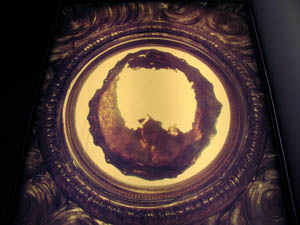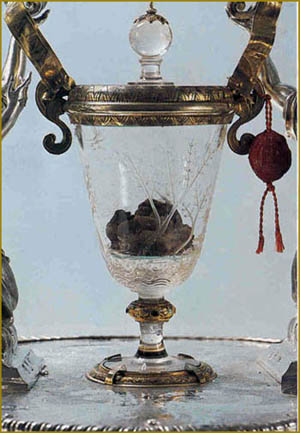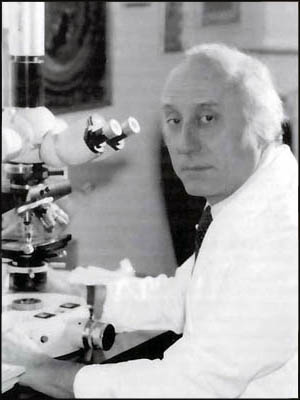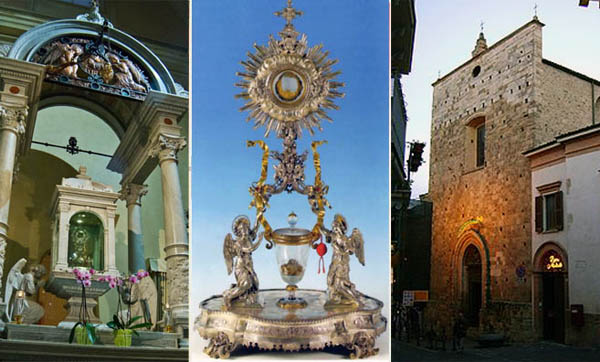 |
Traditionalist Issues
The Eucharistic Miracle of Lanciano
Prof. Remi Amelunxen
For the priests who do not accept as true either the Transubstantiation or the need to believe in it to confect the sacrament, discussed in my last article, I suggest they read the book Eucharistic Miracles by Joan Carroll Cruz. (1) It points out that there have been 36 major Eucharistic miracles, as well as hundreds of lesser ones, such as Hosts that have levitated or bled.

Above, the miraculous host become Flesh;
below, the wine that became Blood
 |
The first and greatest of these is the Miracle of Lanciano in Italy. The description of this marvel confirms the dogma of the Real Presence of Our Lord in the Sacred Host.
Around the year 700 in the Monastery of St. Longinus (the Roman soldier who pierced the side of Christ with a lance), a priest-monk of the Order of St. Basil was celebrating the Sacramentary of St. Gregory the Great (dating from around 600 A.D.), a Mass very close to our present Tridentine Mass. Having suffered recurring doubts about Transubstantiation, he had just spoken the solemn words of Consecration when the host was suddenly changed into a circle of Flesh and the wine transformed into visible Blood. Weeping joyously, he hastened to call the other monks to witness this stupendous miracle.
The Flesh remained intact, but the Blood in the chalice soon divided into five pellets, reminding one of the five wounds of Christ of unequal size and irregular shape. The monks decided to weigh the pellets. It was discovered that the combined weight of the five clots of Blood was equal to the individual weight of any one of them, a miraculous confirmation of the Church teaching that Our Lord is as equally present in the smallest piece of the Host as the whole Host.
That same Host made Flesh remains intact until this date, and today it is enclosed in a monstrance of finely sculptured silver and crystal. The globules of Blood are held in a chalice of etched crystal thought to be the original where the miraculous change occurred.
Through the centuries there have been a number of careful authentications. In 1970 the most detailed scientific investigation was carried out by noted scientists in many different fields (hematologists, anatomists, pathologists, histologists, biochemists, etc.), and led by the renowned Italian Doctor and Professor Odoardo Linoli.
On examining the monstrance, it was observed that the lunette containing the Flesh was not hermetically sealed; that is to say, even though it had been exposed to atmospheric and biological agents, it had not decomposed since the year 700. It was also found that the center of the Sacred Host – the only part that remained bread – had entirely decayed. The five pellets of Blood had not changed in appearance over the centuries and were incorrupt.
In short the conclusions of the scientific data are:

Prof. Linoli headed a team of scientists who examined the Eucharistic miracle |
- The Flesh is striated muscular tissue of the myocardium (heart wall), having no trace whatsoever of any agents used for preservation.
- The Blood and the Flesh were found to belong to the rare blood type AB.
- The Blood of the Eucharistic miracle was found to contain the following minerals: chloride, phosphorus, magnesium, potassium, sodium and calcium, all normal components of blood. The protein components were normally fractionated with the same percentage ratio as those found in normal fresh blood.
- All the scientists agreed that the Flesh and Blood would have rapidly decayed without effective preservatives.
- Professor Linoli, famous for anatomical studies, conclusively excluded the possibility of a fraud, affirming that no human hand could have made such an expert cut from the Heart, which was made tangentially, that is, a round cut, thick on the outer edges and lessening gradually and uniformly into the empty central area.
For the great multitude of pilgrims – including myself – who have witnessed this great miracle and who truly believe in Jesus Christ, there can be no doubt that Transubstantiation actually effects His presence. It has been the traditional belief of the monks at Lanciano since the great miracle occurred that when the the priest says, Corpus Domini Nostri Jesu Christi custodiat animam tuam in vitam aeternam, Amen, and we receive the Sacred Host, what we are receiving is the Flesh and Blood of His Sacred Heart. The fact that the Sacred Host of Lanciano is the myocardium of the heart and that the Blood fell from the Host into the chalice gives much credibility to this belief.
May this great Eucharistic miracle pierce the heart of those skeptical priests so that they fully realize that in every true Holy Communion, Our Lord is really present. And may it put to rest any doubts about the great miracle of Transubstantiation.
Also, may this encourage the priests who says the Tridentine Mass, the Mass of the Great Saints, Popes and Doctors of the Church, to recite every word of the consecratory formulae for the bread and wine slowly and with great reverence, as prescribed at the Council of Florence, keeping in mind that Transubstantiation is at the very heart of the Catholic Church. Who but a priest has the heavenly power to bring Christ from Heaven to us poor creatures on earth?

Until today, the faithful venerate the Sacred Body and Blood of Christ at the Church of San Francisco in Lanciano, Italy |
1. Rockford: TAN, 1987, 305 pp.

Posted April 9, 2012

Related Topics of Interest
 The Priest’s Intention in Consecrating the Eucharist - I The Priest’s Intention in Consecrating the Eucharist - I
 Mysterium Fidei Mysterium Fidei
 The Eucharistic Miracle of Avignon The Eucharistic Miracle of Avignon
 The Magnitude of the Gift of the Holy Eucharist The Magnitude of the Gift of the Holy Eucharist
 Our Debt of Gratitude to the Holy Eucharist Our Debt of Gratitude to the Holy Eucharist
 ‘Be Confounded by Your Ingratitude’ ‘Be Confounded by Your Ingratitude’
 Our Lord’s Affection in Giving Us the Eucharist Our Lord’s Affection in Giving Us the Eucharist
 The Value and Efficacy of the Holy Eucharist The Value and Efficacy of the Holy Eucharist
 How to Dress in the Presence of the Blessed Sacrament How to Dress in the Presence of the Blessed Sacrament
 How a Mule ‘Adored’ the Blessed Sacrament How a Mule ‘Adored’ the Blessed Sacrament

Related Works of Interest
|
|
Traditionalism | Hot Topics | Home | Books | CDs | Search | Contact Us | Donate

© 2002- Tradition in Action, Inc. All Rights
Reserved
|
 |
|